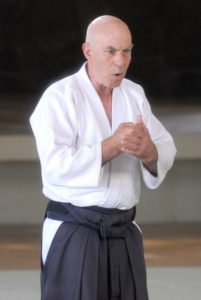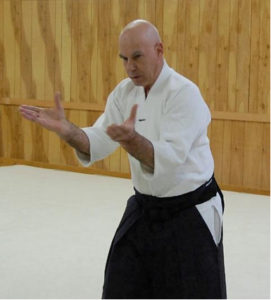This was originally posted on Gleason sensei’s Blog in 2018. If you can Join us for our seminar in November 1-3, 2019
Bill Gleason Sensei
Aikido & the Eight Powers part 1
In the teachi ngs of the founder we find. “Aikido is One Spirit, Four Souls, Three Origins and Eight Powers. Lacking an understanding of this Aikido cannot be grasped.” I have dealt at length with One Spirit, Four Souls, and Three Origins, yet it remains to clarify the meaning of the eight powers. The single ideograms (Kanji) representing each of the eight powers have been translated, yet only directly and without clarification of the real meaning intended or how it relates to our Aikido practice.
ngs of the founder we find. “Aikido is One Spirit, Four Souls, Three Origins and Eight Powers. Lacking an understanding of this Aikido cannot be grasped.” I have dealt at length with One Spirit, Four Souls, and Three Origins, yet it remains to clarify the meaning of the eight powers. The single ideograms (Kanji) representing each of the eight powers have been translated, yet only directly and without clarification of the real meaning intended or how it relates to our Aikido practice.
The Eight Powers are an overview of all natural power. The power of nature is never unidirectional or manipulative, but rather always the product of the balance of yin and yang forces. Considered individually, each of the eight powers are a priori entities. They have no actual existence until they interact with their opposites. Without the interchange of yin and yang, there is no Aiki and therefore no manifestation.
To describe all eight powers here would be too lengthy and so I will begin with the first four and then follow up with the remaining four in a future blog. The implications are rich and numerous, yet it is necessary here to stick with a bare bones explanation just to introduce the subject for those who are truly trying to grasp the teachings of Ueshiba Morihei, O-sensei
Unity and Separation. Heaven and Earth
Unity is the world of ki, or spirit, and separation is the manifest, or physical world. In reality these are two inseparable aspects of one reality. Our physical movement should be independent from our partner, yet we must be completely unified through ki or mind. Only in this way can both freedom of movement and harmony with our environment be achieved. It is because we are completely unified with all things that we have the responsibility to move independently. Lacking this understanding we cannot avoid conflict.
Tension – Release. Thunder and Wind {Wood}
Tension is intent, the first manifestation of the life will itself. It is that which gives birth to yin and yang and therefore to movement and form. It is the explosive force of creative ki. In Aikido it is our De-Ai, coming out to meet our partner’s force.
At the moment of contact there is release, yet ki remains extended. Saotome sensei refers to it as “Bio-feedback.” This allows for the absorbing and nurturing of ki inside. Spiral movement drawing ki inside creates ki-musubi. In other words sending our ki outward is for the purpose of physically receiving and unifying with our partner.
Aikido & the Eight Powers part 2
In the July post, I explained the first two sets of the eight powers. Before moving on, it may be useful to categorize them into yin and yang groups. The Yang powers are examples of expanding, or creative ki. The Yin powers are receptive and nurturing energy.
They are as follows:
Yang Yin
Heaven * Unity Earth * Separation
Thunder * Tension Wind * Release
Fire * Movement Water * Rest
Lake * Expansion Mountain * Stability
Each of these four sets has a technical side, as related to the practice of Aikido, and a spiritual side, which relate s to our daily life. In reality the four pairs complement each other and cannot exist as separate entities. The spiritual side of Thunder and Wind is health and vitality. The water ki of wind, nurtured deep inside our kidneys, creates our vitality and determines the length of our life.
s to our daily life. In reality the four pairs complement each other and cannot exist as separate entities. The spiritual side of Thunder and Wind is health and vitality. The water ki of wind, nurtured deep inside our kidneys, creates our vitality and determines the length of our life.
The next set is that of Fire and Water, the powers of Movement and Rest. The teaching is that Fire moves and water is moved. In other words, it is the mind that moves and the body that is moved. In Aikido practice, the projection of your mind must pass through your partner before physical contact is established. This pure and unrestricted movement of mind is the kototama of Shi and Su.
Water is “rest,” yet this is not stopping. Aikido techniques must always be performed in motion. Water here symbolizes the tightly wound spiral of principle (Ri). It is conformity to this principle that redirects outside force, slowing it down and creating harmonious form. This is Takemusu Aiki.
In Aikido practice the principle of fire and water manifests as Movement before contact and Kuzushi, taking your partner’s balance, upon contact. Unless we receive our partner’s power with rotation there will be a collision of force. The attempt to create form directly has the same result. Force against force kills Aiki.
At this point the spiritual aspects of these two powers should be somewhat clear. Fire is free movement, the creative aspect of mind. When this ki is redirected according to principle and higher reason, harmony and a peaceful environment are the natural result. This is impossible if we are self-serving or shortsighted in our outlook. In the words of Confucius “At seventy years old, I was able to do whatever I wanted and still conform to the way.”
Aikido & The Eight Powers part 3
Finally, although there is always more to say about Aiki principle, I would like to attempt to briefly summarize this topic of The Eight Powers. As discussed in the July blog, the unity of Heaven and Earth creates the overview of the Eight Powers. Heaven is yang creative force, the detail of which is expressed in Thunder and Fire, and finally summarized in the symbol of the Lake.
Earth, on the other hand, governs the Yin, receptive powers, of Wind and Water, and comes to its completion in the symbol of the Mountain. Heaven and Earth represent individuality and universality as one. This recalls the words of the founder, Ware Soku Uchu, Uchi Soku Ware, “The universe and I are one and the same.”
The last two symbols, in the order that I have presented them, are Lake and Mountain. Mountain symbolizes Fudoushin, immovable mind and body. This is the level of mastery. It is the Eight Powers rooted by the life Will and Power. It should be noted here that, in the words of the monk Takuan, ”Immoveable mind is the mind that is always in motion.”
The stability of the body as well, is not a rigid state; movement inside the body creates it. The statement, “Movement in rest and rest in movement” also points towards this reality. Stability is the foundation of control upon which mastery rests. The exterior expression of this mastery is the gentle emanation of ki, a peaceful aura of wisdom reflecting whatever comes before it. This is shown in the symbol of the Lake.
body as well, is not a rigid state; movement inside the body creates it. The statement, “Movement in rest and rest in movement” also points towards this reality. Stability is the foundation of control upon which mastery rests. The exterior expression of this mastery is the gentle emanation of ki, a peaceful aura of wisdom reflecting whatever comes before it. This is shown in the symbol of the Lake.
The symbol of the Mountain represents the Eight Powers within a square. The square is “endless variation,” what the founder referred to as Takemusu Aiki. He further explained it as “Standing on the Floating Bridge of Heaven.” It is to stand in the center, here and now, and freely balance yin and yang in motion.
Mountain symbolizes completion and perfection just as Thunder symbolizes the beginning, or exciting, of movement. Thunder is intent flying out in all directions, It is youth and vitality. Lake, on the other hand, is the peaceful emanation of ki. It is the difference between youthful energy and the gentle power of a master.
The symbol of the Lake shows the kototama of Ti, which is the fullness of both ki and wisdom. This is the Eight Powers represented through the activity of the Circle, the infinitely expanding ki that creates all things. Ti may be seen here as an abbreviation of Michi, the path, or Way of Life, of a true human being.

Recent Comments